B2B Marketing Playbook: 7 Steps To Plan A Perfect Project
In the fast-paced marketing world, cracking the code to effective B2B strategies can feel like navigating a maze of creative demands, budget limitations, and channel complexities.
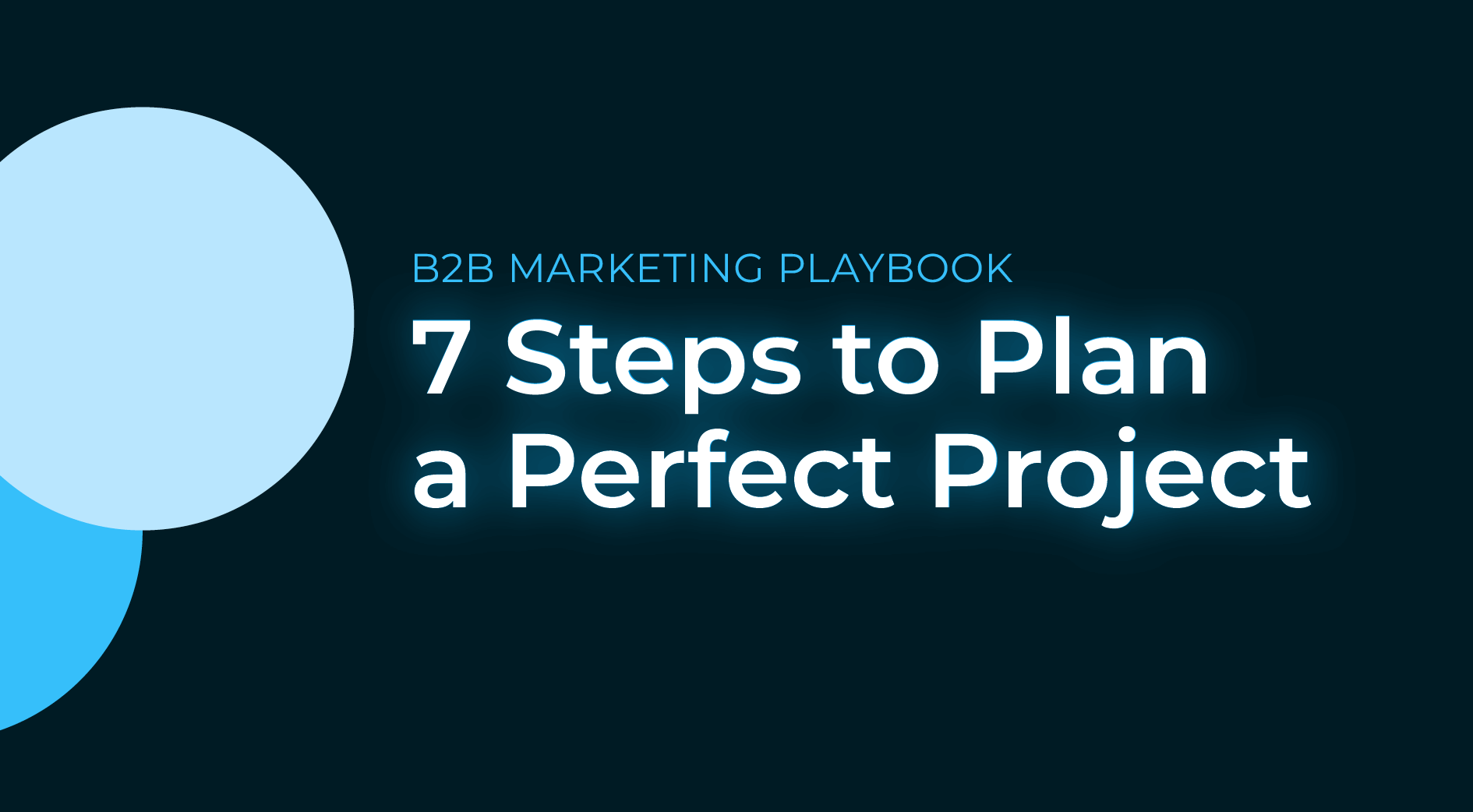
In the fast-paced marketing world, cracking the code to effective B2B strategies can feel like navigating a maze of creative demands, budget limitations, and channel complexities.

In the fast-paced marketing world, cracking the code to effective B2B strategies can feel like navigating a maze of creative demands, budget limitations, and channel complexities. Amidst these challenges, understanding your audience becomes the pivotal factor that holds the key to success.
Gone are the days of generic marketing approaches. Tailoring your message to resonate with the right buyers is paramount. This is where B2B marketing takes the stage, offering a distinct playbook designed to engage and convert businesses rather than individual consumers.
Prepare to discover the untapped potential of B2B marketing, empowering your business with the tools to conquer new horizons. From unravelling the most effective strategies to capture the attention of your business audience, this article will equip you with the insights and trends essential for thriving in the dynamic B2B landscape.
Business-to-business (B2B) marketing refers to the strategies businesses use to sell their products or services to other businesses instead of individual consumers. It involves targeting organisational decision-makers, building relationships, and generating leads to drive sales.
B2B marketing showcases the value, benefits, and suitability of products or services to meet the specific needs and challenges businesses face in their industries.
B2B (business-to-business) marketing targets businesses, focusing on building relationships, generating leads, and driving sales between organisations. It emphasises meeting specific business needs and involves complex decision-making.
B2C (business-to-consumer) marketing targets individual consumers, aiming for immediate purchasing decisions. It appeals to personal emotions and desires, showcasing product benefits and features to capture consumer interest and drive transactions.
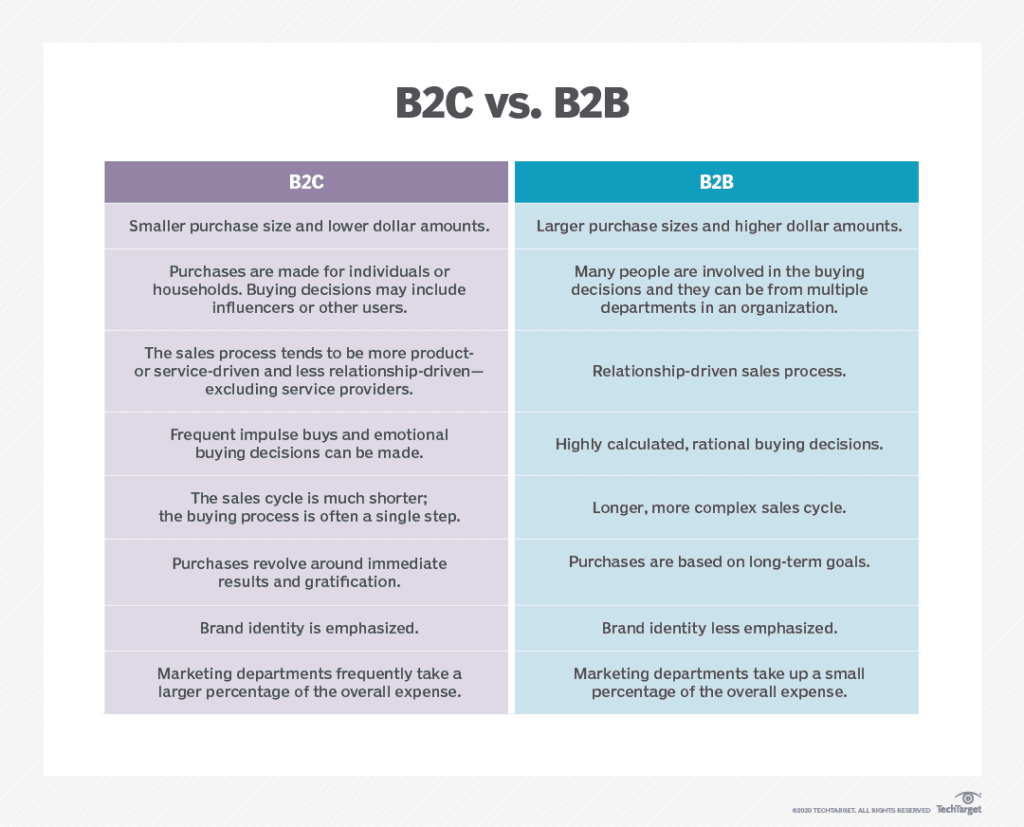
Image credit: TechTarget
B2B marketing is relationship-driven, meeting business needs, while B2C marketing is consumer-centric, appealing to personal preferences.
As you embark on your journey to business success, navigating the B2B sales funnel is crucial. This strategic framework guides organisations through the intricate process of converting prospects into valuable customers.
Let’s delve into the inner workings of the B2B sales funnel, exploring each stage and uncovering key strategies to maximise your sales effectiveness and drive sustainable growth.
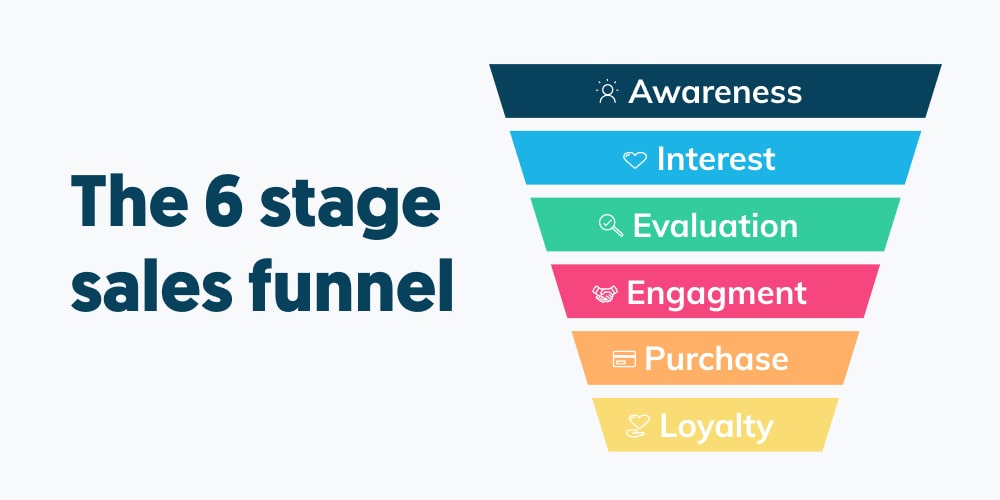
Image credit: WiseStamp
The B2B sales funnel encompasses six key stages:
The B2B sales funnel framework demonstrates its adaptability across industries and business models through various variations.
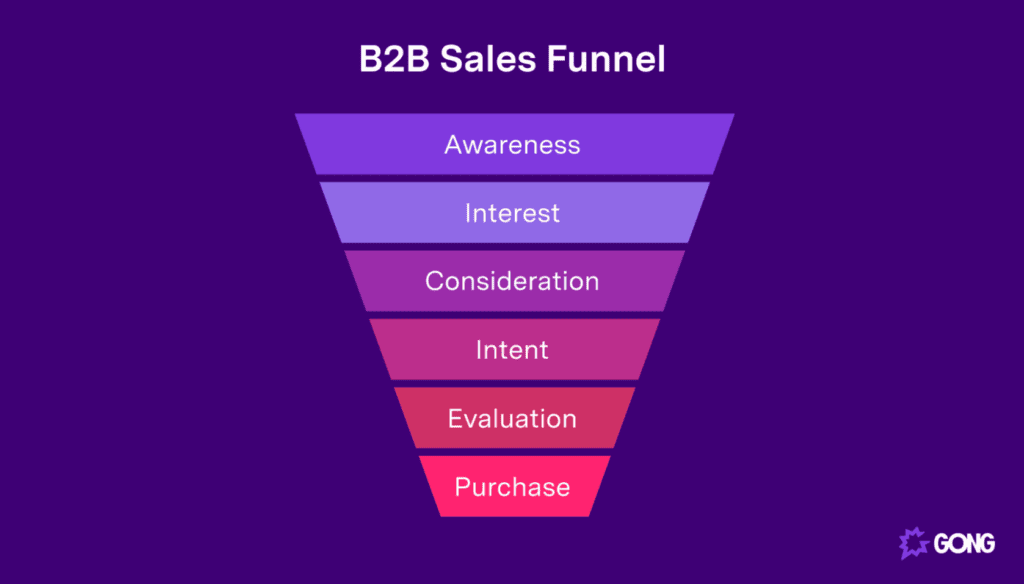
Image credit: Gong
For example, the B2B sales funnel chart in the image above illustrates a variation where “consideration” is placed as the third stage and “evaluation” as the fifth stage, showcasing the flexibility of the funnel’s structure.
As you embark on your journey to business success, navigating the B2B sales funnel is crucial. This strategic framework guides organisations through the intricate process of converting prospects into valuable customers.
Once prospective buyers have identified a problem, they begin looking for solutions that can span several months to a year before settling on a supplier.
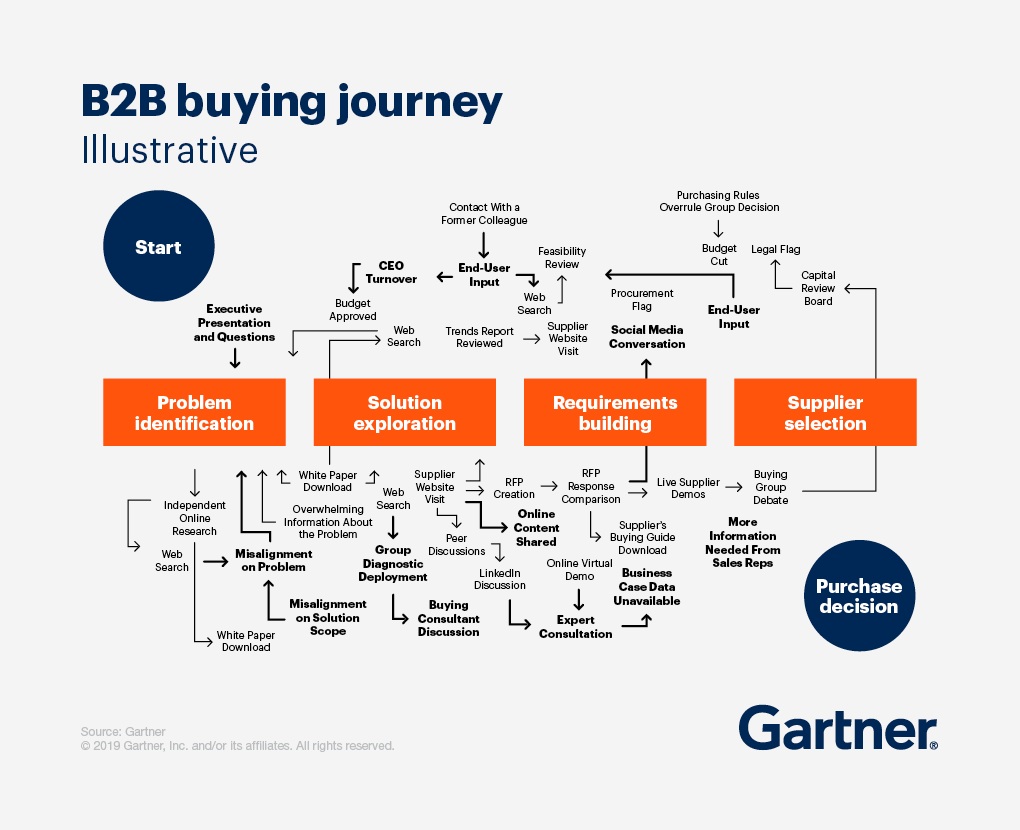
Image credit: Gartner
The key thing to point out here is the dynamic decision-making process. Often it involves several stakeholders, from chief executives, sales, and customer service reps to legal and compliance teams.
B2B buyer personas are a valuable tool to unlock the true potential of targeted marketing and engagement strategies. These carefully crafted profiles go beyond mere demographics, delving into the intricate layers of an organisation’s decision-making process.
By capturing critical information such as job roles, pain points, motivations, and preferences, B2B buyer personas provide a deep understanding of the individuals behind the buying decisions.
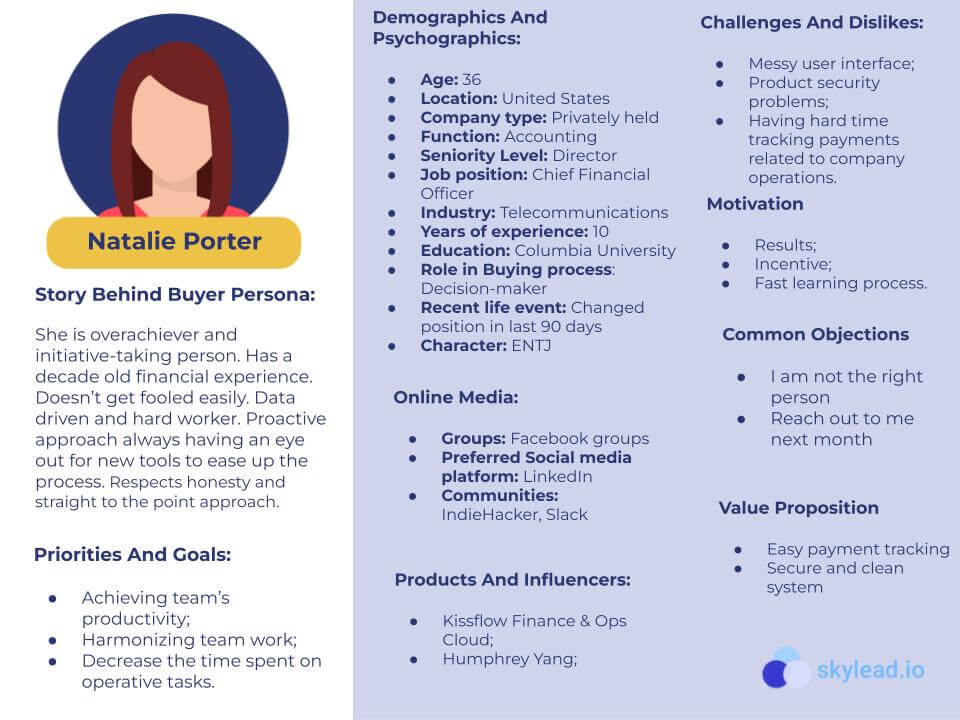
Image credit: Skylead
In the example of Natalie Porter, notice how it goes into specifics. For instance, she changed her role within 3 months, considering the influencers she follows, her preferred social media channels, and what online communities she is a part of.
These granular details contribute to a more holistic understanding of Natalie as a unique buyer persona, allowing businesses to tailor their marketing approaches to resonate with their target audience on a personal level.
By leveraging the insights derived from B2B buyer personas, businesses can forge meaningful connections with their ideal buyers, driving engagement, conversion, and long-term customer loyalty.
Pega is a global software company specialising in customer relationship management and digital process automation. They sought to:
Pega conducted a thorough analysis to identify three buyer personas. They audited their existing content and filled any gaps to align with the buyer’s journey. To gain deeper insights into these personas, Pega researched thoroughly researched and collected data on their information sources, including but not limited to forums.
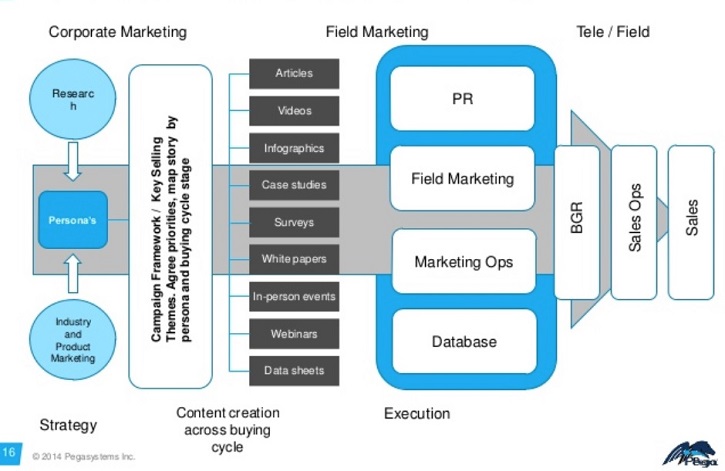
Image credit: Tomislav Horvat
Creating buyer personas paid off spectacularly. Pegas underwent a remarkable transformation, including:
By making changes to its digital marketing strategy, Pega was able to propel business growth while at the same time fostering brand consistency.
Understanding your target audience is super important in B2B marketing, especially when connecting with real people. That’s where the magic of quantitative and qualitative data comes in.
Quantitative data is all about numbers and measurements. It’s like taking surveys and crunching data to learn how people behave as buyers and what groups they belong to. It’s all about the facts and figures.
On the other hand, qualitative data dive into the juicy stuff — people’s thoughts and feelings. It’s like having conversations, getting feedback, and joining group discussions. This data type helps us understand what motivates them, their challenges, and how they make decisions.
It adds a personal touch to our marketing, making it more relatable and human, just like chatting with friends.
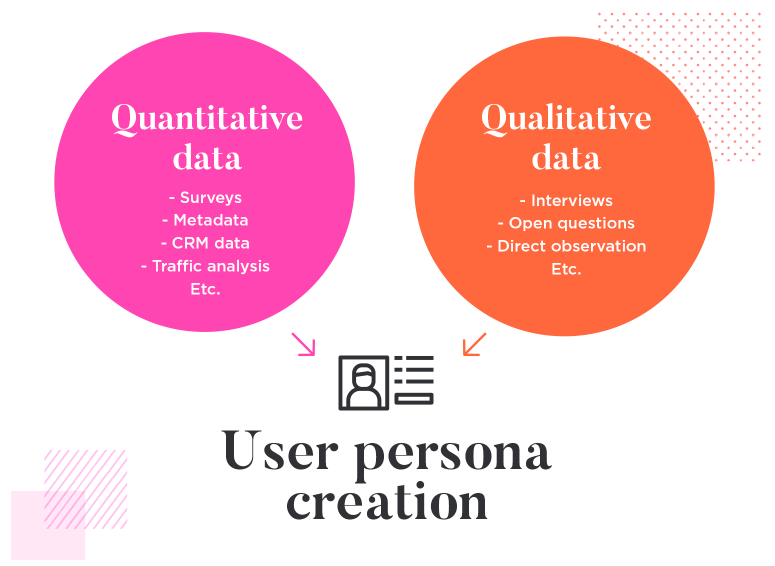
Image credit: Justinmind
A strong marketing persona is formed when both data types are combined. This persona becomes a valuable tool for creating customised and personalised marketing strategies.
Creating an effective B2B marketing strategy is paramount in today’s competitive landscape. To stand out from the crowd and drive meaningful results, businesses need a well-thought-out plan that aligns with their goals and resonates with their target audience.
Start by clearly outlining your marketing objectives. Whether generating leads, increasing brand awareness, or driving conversions, setting specific and measurable goals is crucial for a focused strategy.
This can be done by using the SMART method.
Here is an example of a SMART goal related to “webinar sign-ups” to understand its detailed breakdown.
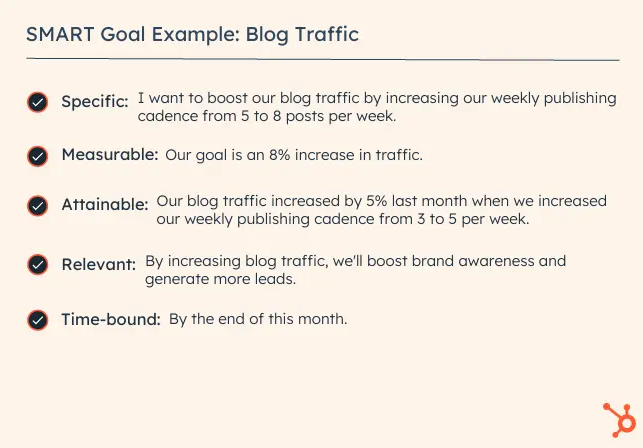
Image credit: HubSpot
Webinars are pivotal in converting B2B leads into sales. Setting a clear goal of achieving a 15% increase in webinar sign-ups is realistic and achievable, representing just 5% growth from their previous webinar performance.
A well-defined marketing budget is essential for B2B companies to drive growth, establish a strong brand presence, and achieve their business objectives. Here’s why it’s important:
According to the CMO February 2022 survey by Deloitte, B2B companies typically allocate around 9.4% to 10% of their revenue for their marketing budget.
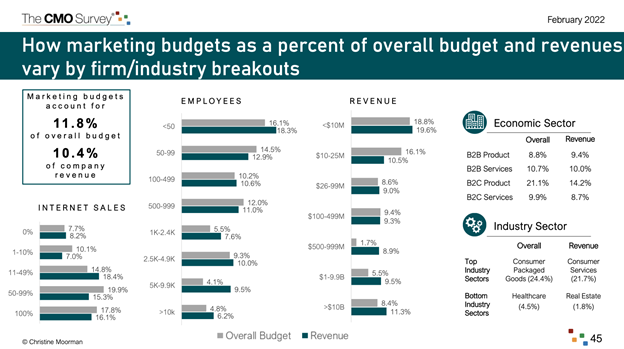
Image credit: Deloitte’s CMO Survey
The marketing budget allocation may differ based on the industry sector and organisational size.
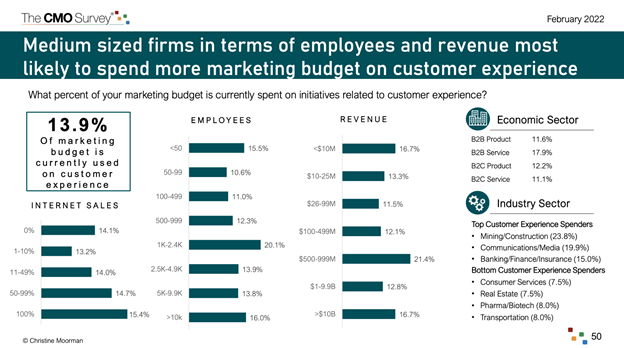
Image credit: Deloitte’s CMO Survey
In the case of medium-sized B2B firms, Deloitte’s CMO Survey discovered that they typically dedicate a percentage of their marketing budget, ranging from 11.6% (B2B products) to 17.9% (B2B services), towards enhancing the overall customer experience.
Understanding your target audience is like unlocking the secret to success. It’s about getting inside the minds of your ideal customers and tailoring your strategies to win them over. Here’s how savvy B2B brands identify their target audience and make a lasting impression:
One successful example is Simplr, a customer support solution. By utilising digital performance data and targeting high-growth brands during their peak growth periods, Simplr improved sales efficiency, higher lead quality, and increased conversion rates.

Image credit: Similarweb
Market sizing in B2B sales refers to estimating the potential market opportunity or total addressable market (TAM) for a specific product or service within a target industry or audience.
Simplr’s approach to market sizing became more dynamic and effective, resulting in better outcomes by perfecting the timing of their outreach.
While some businesses may use the expressions value proposition and unique selling point (USP) interchangeably, they have distinct meanings.
A value proposition is a short and catchy statement that tells other businesses why they should choose and buy from a company. It answers the question, “Why should customers choose us?” It communicates a company’s overall value and benefits, highlighting the unique combination of products, services, and advantages that make it stand out.
On the other hand, a unique selling point (USP) is a specific feature or aspect of a product or service that distinguishes it from others in the market. It answers the question, “What makes our product different or better?” It focuses on a single key selling point that sets the product apart and makes it attractive to customers.
Businesses can effectively communicate their competitive advantages and attract customers by developing a compelling value proposition and identifying a strong, unique selling point.
One company that demonstrates these principles well is Zapier. Their website prominently features “automate” and “easily,” encapsulating their value proposition and addressing the desire for streamlined workflows. Zapier enables brands to connect apps without requiring coding knowledge, which serves as their unique selling point.
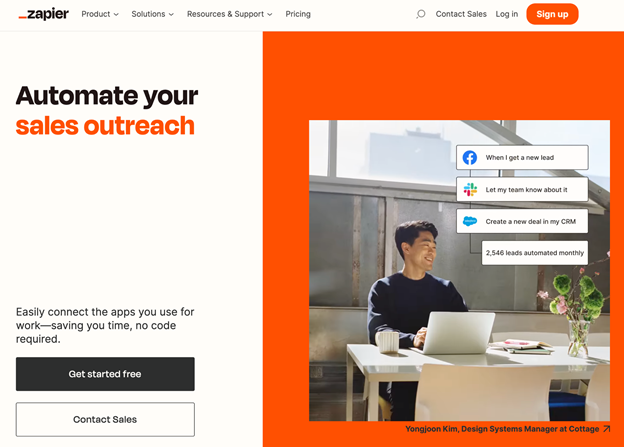
Image credit: Zapier
Zapier goes the extra mile by providing two options for customers to get started: the DIY approach or hiring an expert. This approach removes friction around a common pain point of setting up with Zapier, showcasing their customer-centric mindset.
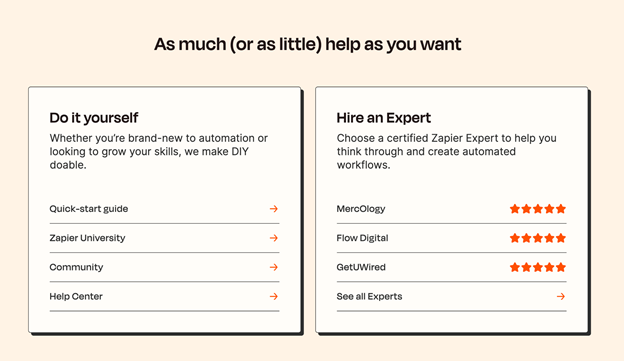
Image credit: Zapier
On TikTok, Zapier also created a series called “Steal this workflow,” showing customers different automation hacks and how easy and quickly they can be implemented.

Image credit: Zapier via TikTok
This specific TikTok video accumulated 86,300 views, 443 hearts, and 20 comments.
These TikTok videos showcase the value of Zapier’s product offering and provide users with exciting possibilities to enhance their work-life through automation. They offer valuable insights and innovative ideas to make work tasks more accessible and efficient.
To develop a strong value proposition, one can use Peter Thomson’s value proposition canvas, which explores the components contributing to a compelling value proposition.
By considering each section from the customer’s perspective, businesses can understand how their product or service brings joy, solves problems, and addresses emotional needs, rational motivators, and potential fears.
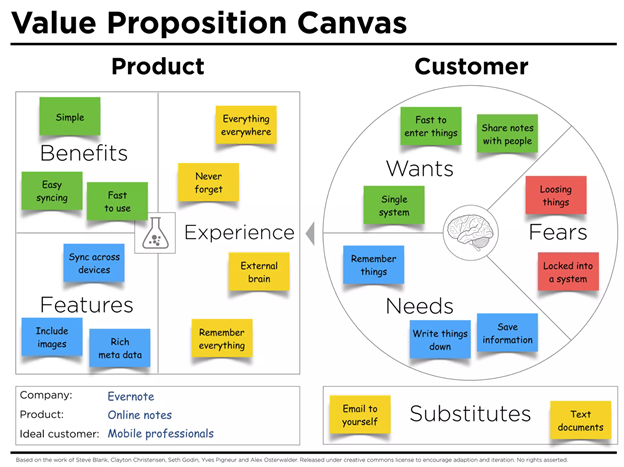
Image credit: Peter Thomson via SlideShare
This approach aligns business strategy with brand strategy, effectively empowering companies to communicate their unique value. Its effectiveness spans various organisations, from new tech startups to industry giants like GE, P&G, and Nestlé.
Researching the competition is crucial for B2B companies as it provides valuable insights into market dynamics, industry trends, and customer preferences.
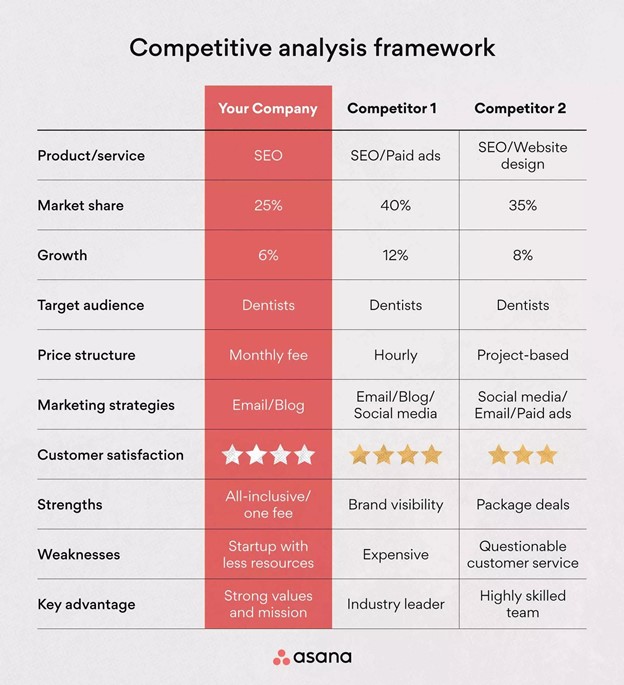
Image credit: Asana
This information serves as a compass to navigate the business landscape and refine its strategies and offerings for a competitive advantage.
A wide array of tools are available for B2B businesses to research their competition.
| Category | Tool | Use |
| Web traffic sources | Semrush, Ahrefs, Moz, and SimilarWeb | Identify competitors’ digital marketing tactics and understand their online presence |
| Social media monitoring | Hootsuite, Sprout Social, Brandwatch, and Brand24 | Monitor competitor campaigns, content strategies, and customer interactions on social media platforms |
| Surveys and feedback | SurveyMonkey, Typeform, Qualtrics, and Qualaroo | Uncover customer perceptions, preferences, and satisfaction levels, providing insights into competitor strengths and weaknesses |
Scripted is a content marketplace competing with big brands like Fiverr, Upwork, Freelancer and Contently.
To differentiate itself from its competitors, Scripted implemented a content marketing strategy targeting each stage of the buyer’s journey, leveraging podcasts, blog content, webinars, white papers, and compelling case studies.
As a result, Scripted achieved impressive results, with 46% of visitors engaging with their content and experiencing significantly lower bounce rates than other traffic sources.
The challenge of generating traffic and leads directly impacts a brand’s ability to attract potential customers, drive business growth, and achieve sales and revenue goals.
An analysis by the State of Inbound found that B2B companies consistently identify generating traffic and leads as their top challenge. That’s why brands should prioritise their marketing efforts towards effective lead generation strategies.
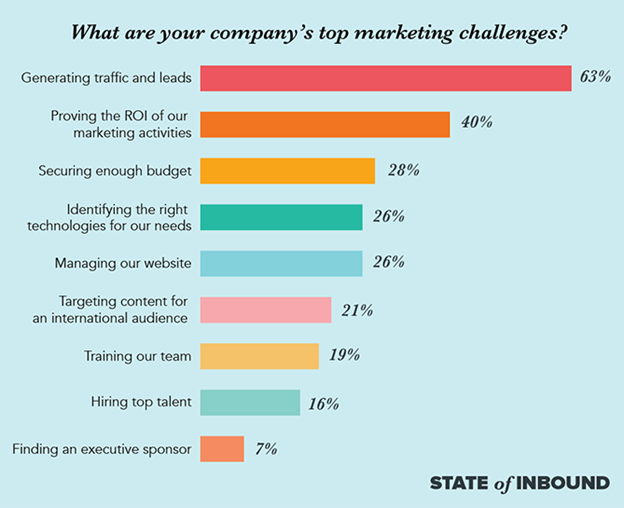
Image credit: Sales Hacker
B2B companies can leverage several lead generation strategies to attract and engage potential customers. Some of the most effective strategies include:
Measuring the success of B2B marketing campaigns can be done in a few different ways. Here are some common methods:
Track conversions: Monitor how many leads or prospects turn into actual customers. This could be measured by the number of sales or the value of the deals closed.
Monitor website analytics: Look at website traffic, page views, and the time spent on each page. This data can give you insights into the effectiveness of your marketing efforts in driving traffic and engaging visitors.
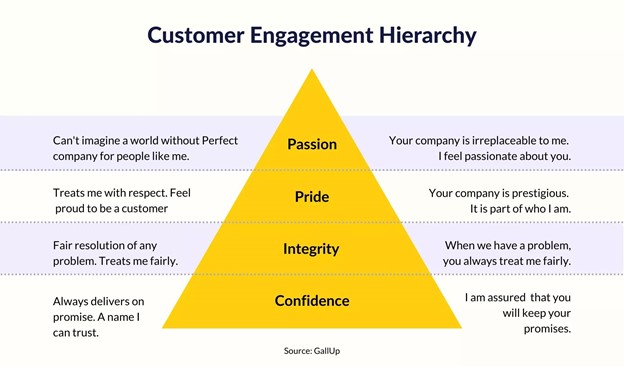
Image credit: GallUp via Hiver
Analyse customer engagement: Measure how people interact with your content, such as downloading whitepapers, attending webinars, or subscribing to your newsletter. This can indicate the level of interest and engagement your marketing campaigns generate.
Assess customer satisfaction: Gather customer feedback to gauge their satisfaction with your product or service. This can be done through surveys, interviews, or online reviews. Happy customers often translate into successful marketing efforts.
Evaluate return on investment (ROI): Calculate the financial return from your marketing activities by comparing the costs incurred with the revenue generated. This helps determine if your marketing efforts are delivering a positive impact on your bottom line.
Remember, success is not limited to a single metric. It’s essential to consider a combination of these factors to understand how well your marketing strategies perform and adjust accordingly.
Here are some effective strategies that companies can use to engage and captivate their target audience.
According to Statista’s data, the number of email users is projected to reach a staggering 4.6 billion by 2025. That’s why it’s a vital communication channel for businesses and marketers worldwide.
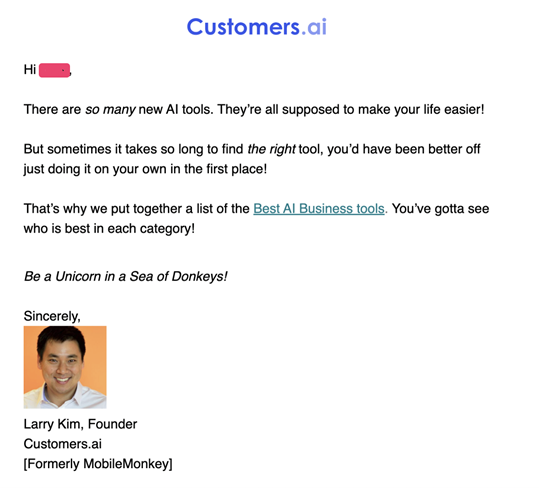
Here’s an example of a recent email that I received from Customers.ai. Here are some quick things to point out:
I recently signed up for Superflows, an email software tool that uses AI to respond to emails.
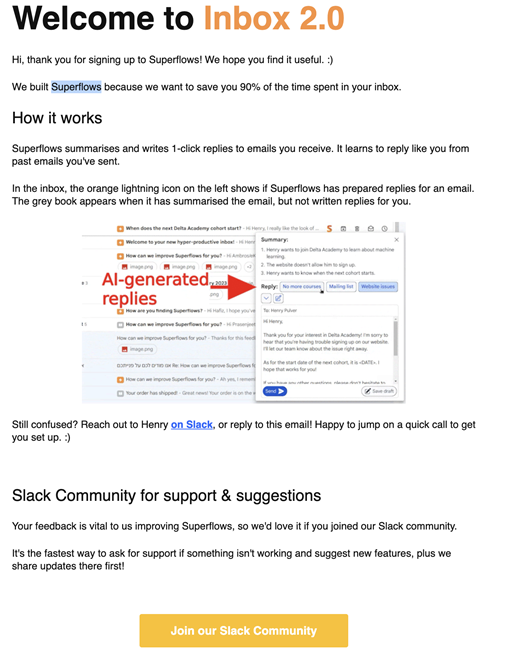
Here are the things worth mentioning in this email:
Account-based marketing (ABM) is a strategy that focuses on specific key accounts and tailors marketing efforts to meet their unique needs. It aims to build personalised relationships and drive business growth by treating individual accounts as distinct markets.
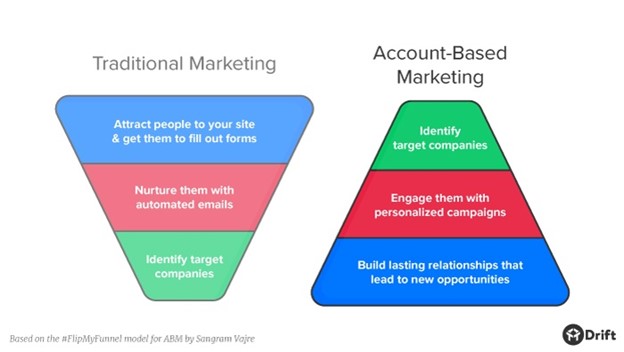
Image credit: Drift
ABM takes more of a long-form approach to generating sales from enterprise companies by focusing on building relationships first. Typically, the sales cycle for ABM can span from 6 months to over a year to secure large-scale accounts valued at six figures or more.
Like with creating buyer personas, ABM takes this to the next level by trying to collate as much information as possible about the key people in an enterprise organisation. Things like:
Then, sales teams will also need to dig deeper and consider things like: Do I know anyone in my circle connected to any of the key decision makers that I could get an introduction to?
ABM account managers (often specific people within a sales organisation dedicated only to ABM) will grade different enterprise accounts into tiers.
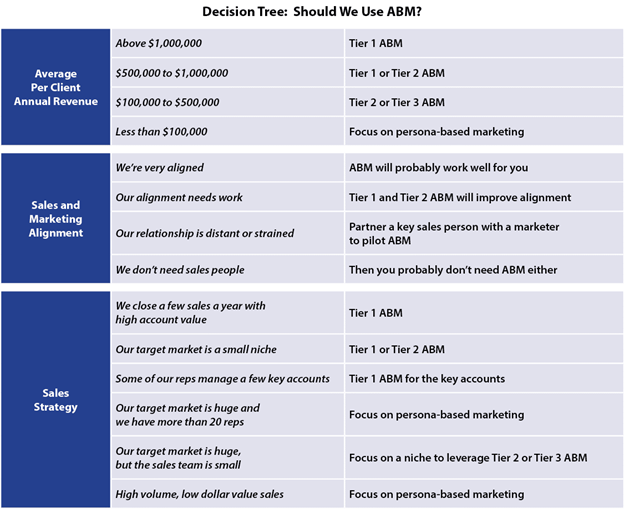
Image credit: PropelGrowth
In the image above, accounts are broken down into:
Generalist salespeople typically manage accounts with a lower value but faster conversion rates.
Here are some useful tools to create an ABM strategy:
Content marketing is a strategic approach that involves creating and distributing valuable, relevant, and consistent content to attract and engage a specific target audience.
It is one of the most popular marketing channels for B2B companies. It crosses over with other marketing activities such as:
Content creation is pivotal in search engine optimisation (SEO). By producing high-quality and keyword-rich content, businesses can improve their organic search rankings, attract more website traffic, and increase visibility in search engine results.
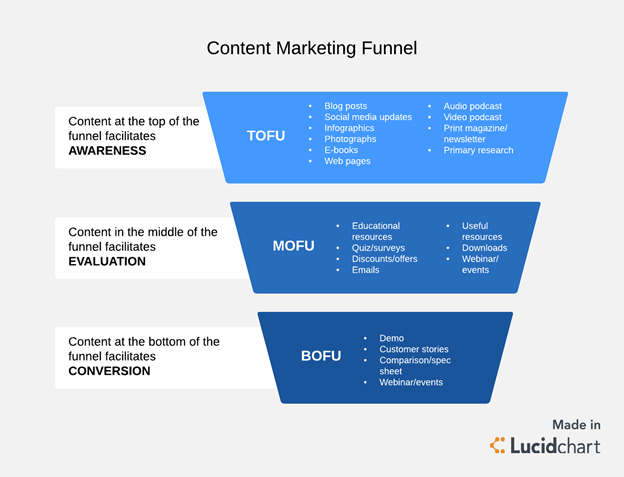
Image credit: Lucidchart
From an SEO standpoint, not only does the content need to target keywords, but it also needs to target different areas of the funnel:
Here is an excellent example of top-of-the-funnel content from Project.co.
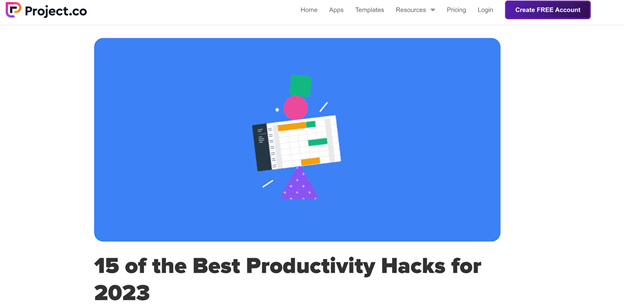
Image credit: Project.co
Anybody searching for productivity hacks is looking for ways to make themselves more efficient and save time. They could be open to trying new products if they can find something that helps them to solve a problem.
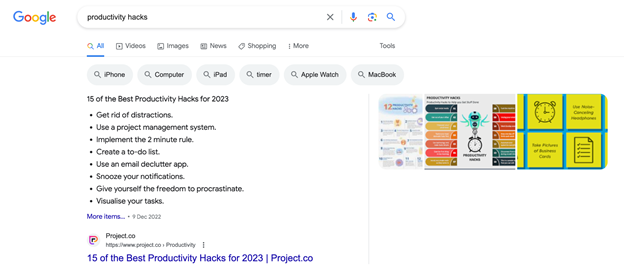
This article by Project.co mentions their product as one of the productivity hacks, and this article is currently ranking in position 1 in Australia for the keyword “productivity hacks,” and holds the featured snippet.
Social media marketing
By crafting compelling content, businesses can drive social media engagement, expand their reach, and encourage audience interaction and sharing.
Sometimes this doesn’t always need to be a blog post as content can hold a variety of forms, for example, a podcast.
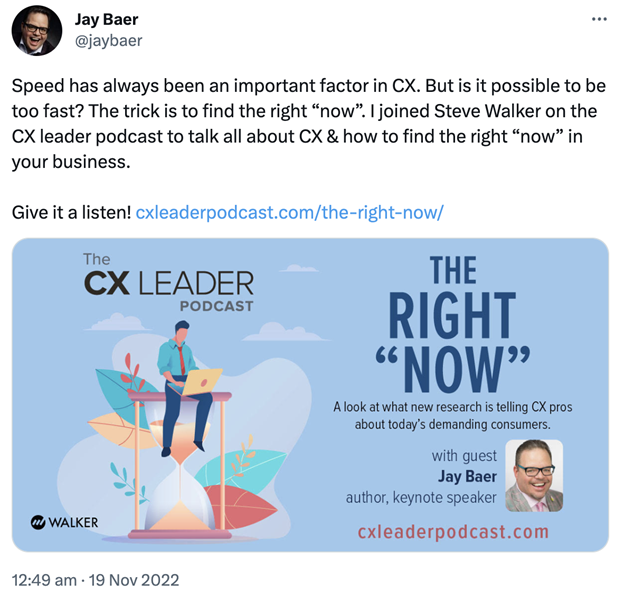
Image credit: Jay Baer via Twitter
In the example above, Jay Baer, a digital marketing influencer, is tweeting about a podcast on which he was recently featured.
But they can also take the form of ads.

Influencer marketing
Influencers often create content to engage their audiences. Collaborating with influencers allows businesses to tap into their established follower base and leverage their content creation skills to amplify brand messages and reach a wider audience.
Here’s an example of Adobe featuring Paris Nicholson, an influencer and host of The Social Dose.

Image credit: Adobe, via TikTok
In the TikTok above, Paris shows users how graphic designers can gain colour inspiration from marine life.
Paid advertising
Content marketing can enhance paid advertising efforts by providing valuable content to support ad campaigns. Landing pages, blog posts, or interactive content can complement paid ads and deliver a cohesive user experience, increasing the effectiveness of paid campaigns.
Here is an example of N.Rich — an ABM software company that is running a Google Ad to one of its landing pages.
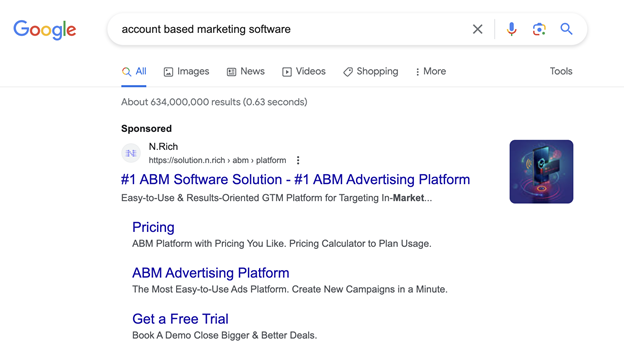
Once a prospect clicks on the Google Ad, they are redirected to this landing page.
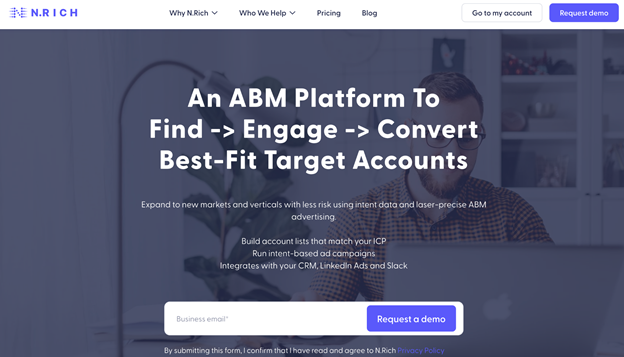
Image credit: N.Rich
When it comes to online advertising, B2B brands have plenty of options. Here are just a few:
The effectiveness of online ads varies based on a brand’s goals, target audience, and industry, emphasising the need to customise ad strategies to meet specific requirements.
PR
PR and content marketing is crucial in building a positive brand image, generating media coverage, and enhancing reputation management.
Adobe’s recent “Creativity For All” campaign featured in Forbes is a prime example of the power of PR and thought leadership content in driving positive change.
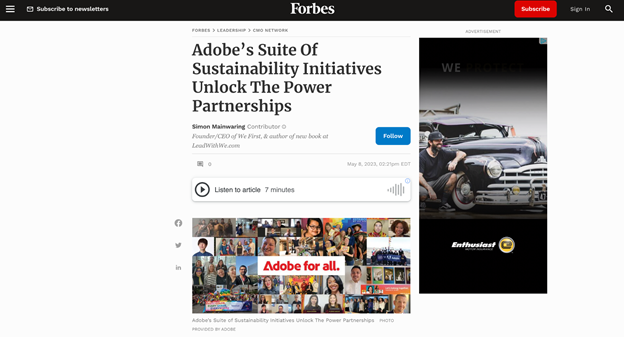
Image credit: Forbes
By highlighting the environmental impact of their digital document solutions like Adobe Acrobat Sign, they raise awareness and inspire consumers to become activists, showcasing the transformative potential of partnering with tech companies for a sustainable future.
Top B2B marketing trends to watch
Market trends for B2B companies constantly evolve, and 2023 is no exception regarding marketing strategies. The emergence of AI, the influence of Gen Z, and the significance of voice search are already making waves in the marketing landscape. Here are the top trends that business marketers should pay close attention to this year.
1. AI-powered marketing
AI has shaken up the marketing game for years, with 61.4% of marketers now using AI in their marketing activities. 2023 has seen a boom in AI-powered marketing tools, including the following:
IBM: The release of Watsonx will revolutionise the AI market by providing self-service access to high-quality data. This allows users to collaborate and build new, generative AI models and traditional systems.
Adobe Marketo: This new tool by Adobe offers AI-powered capabilities to help marketers drive personalised and effective marketing campaigns. Allowing brands to create cross-channel experiences, sync marketing and sales, and measure the success of every customer
touchpoint, Marketo is set to revolutionise B2B marketing strategies and optimise and automate the sales cycle.
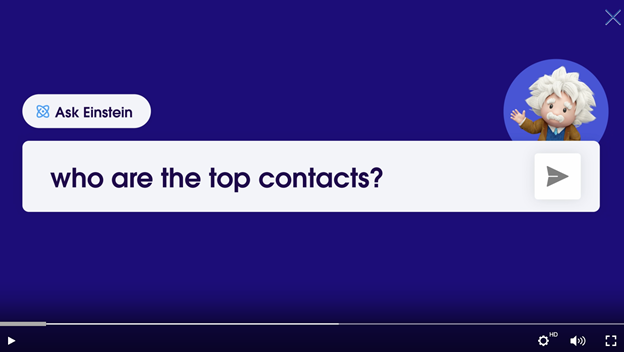
Image credit: Salesforce
Salesforce Einstein: With Salesforce’s Einstein AI tool, sales teams can streamline customer relationship management to influence a favourable purchase decision. With features such as the AI customer service tool, B2B businesses can use Einstein to automatically assign cases to the most suitable agents based on their skills and availability, improving customer service.
ChatGTP: Over 100 million people use ChatGTP. It allows marketers to conduct surveys and gather market insights better to understand trends, customer preferences, and product feedback. Using this data, B2B businesses can better tailor their marketing strategies, product development, and decision-making to their audience.
2. Customer experience (CX)
In a fiercely competitive B2B market, prioritising customer experience is pivotal for attracting and retaining customers. Let’s take a look at some examples.
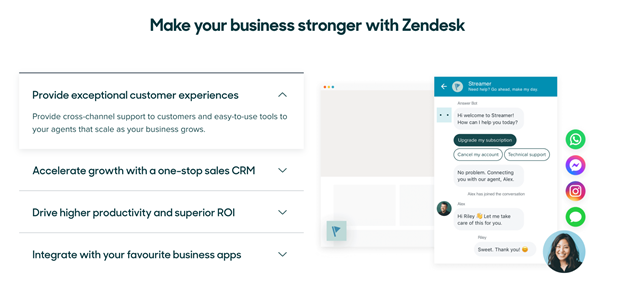
Image credit: Zendesk
Zendesk tailors its marketing to address pain points and challenges that businesses face in their customer support journey. By providing personalised messages and content that resonate with its target audience, Zendesk showcases the value of its software solutions.
Hubspot uses an inbound marketing approach, creating valuable and personalised content. It provides educational resources, webinars, and blog articles that empower businesses to improve the customer experience and attract, engage, and convert casual visitors into dedicated clients.
Salesforce uses the customer insights and data it collects to deliver personalised ad campaigns. Using targeting strategies to ensure relevant marketing content, Salesforce can better solve customer needs and pain points. This focus on personalisation enhances the CX of new and existing customers.
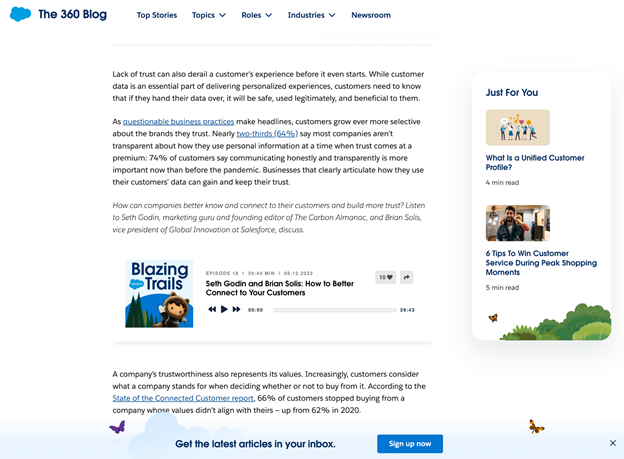
Image credit: Salesforce
By looking at the Salesforce blog article above, you may notice a couple of things:
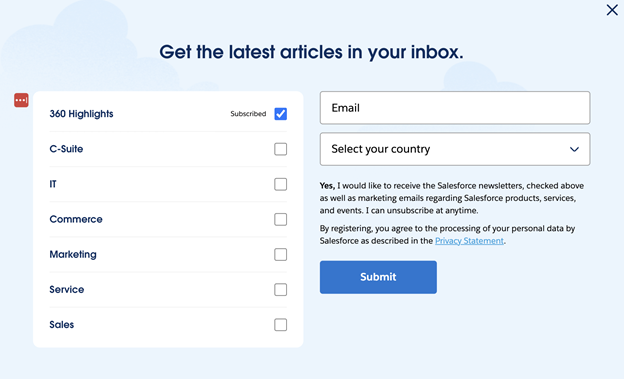
Image credit: Salesforce
When a Salesforce user clicks on “sign up now,” they’ll receive a personalised opt-in that lets users personalise what content they’d like to receive from Salesforce.
3. Gen Z’s growing influence on marketing
Gen Z’s influence on marketing is crucial for businesses to acknowledge, as this demographic holds immense purchasing power and will shape the future. Adapting marketing strategies to align with Gen Z’s preferences and values can increase brand relevance, customer engagement, and sustainable business growth.
To effectively target Gen Z, utilise visual and bite-sized content formats such as short videos, infographics, and visually appealing images. Break down complex information into easily digestible and shareable content.
Adobe is a prime example of a company catering to Gen Z. Through its suite of creative software tools, like Adobe Creative Cloud, tailored for designers, artists, and content creators, Adobe showcases software capabilities with engaging content, tutorials, and case studies.

Image credit: Adobe via Marketing Communication News
This approach resonates with Gen Z’s creative aspirations, as seen in the captivating Adobe Creative Cloud advertisement.

Image credit: Adobe via YouTube
In addition, Adobe effectively tapped into the pride community by leveraging YouTube videos and other media, showcasing its commitment to inclusivity and diversity.
4. Voice search
With the growth of voice-enabled devices and advancements in voice technology, how professionals seek information and engage with digital content is being shaped and transformed.
Even though the technology is still in its early stages, adoption will likely continue as people begin getting used to searching for things via their voice instead of typing.
Voice searches are more conversational and use natural language than typed searches. Research specific phrases from your target audience to make results feel more natural.
For instance, GE Lighting uses voice search technology from Alexa and Google Home to allow its customers to switch lights off and on automatically.

Image credit: GE Lighting via YouTube
In the GE Lighting video, two kids sit on the sofa, engrossed in whatever is playing on the TV. Meanwhile, the young girl effortlessly commands the lighting using voice recognition technology.
Adding to the playful atmosphere, her father, appearing in the background, playfully assumes the persona of “Bandit Heeler,” the lovable dad from the popular TV series Bluey.
With each voice command the girl utters, her dad cleverly adjusts the controls, mimicking the mischievous antics of the beloved character.
5. Analytical sales skills
A recent B2B survey by McKinsey & Company highlights the importance of analytical and quantitative skills, with an overwhelming 80% of sales leaders ranking these capabilities as top priorities for development.
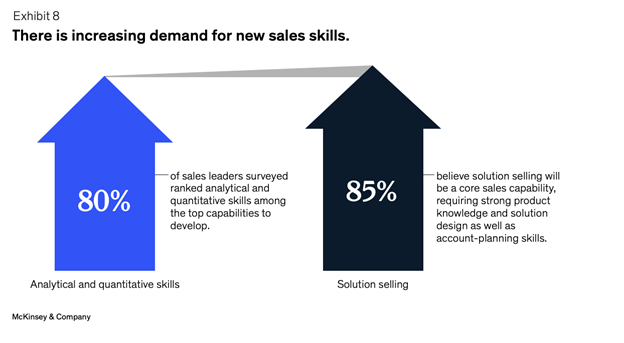
Image credit: McKinsey & Company’s Future of B2B Sales Report
As sales teams become increasingly sophisticated, there will be a growing demand for sales reps to be more analytical with their sales accounts to close deals.
To excel and maintain a competitive edge in the market, sales teams must embrace data-driven approaches, as those who fail to do so risk being left behind by their more forward-thinking competitors.
Looking to enhance your B2B marketing strategy?
Look no further than IMAB2B, the leading marketing, strategy, and consulting company. Our unmatched full-service offering combines a traditional consultancy’s expertise with an advertising agency’s creativity.
From strategic consulting to customer acquisition, production to web development, our dedicated teams deliver exceptional results without the typical fluff. Contact us today to unlock your business’s potential and engage your target audience like never before.
The latest industry news, interviews, technologies, and resources.
Due to complex stakeholder relationships, B2B marketing for large building companies and industrial construction leaders can be challenging. Knowing what drives and motivates decision-makers and key opinion leaders (KOL) is crucial.
Read postI.M.A are proud to have given our support and resources to launch a funding drive for nurses at Campbelltown and Camden Emergency Departments to participate in the Advanced Paediatric Life Support training program.
Read postWe’re all ears, and we’re here to help you grow your business.